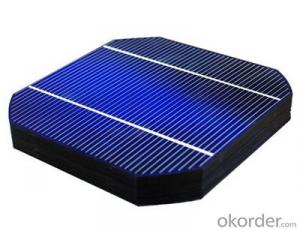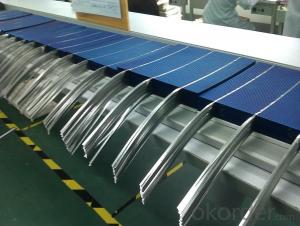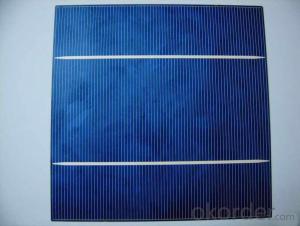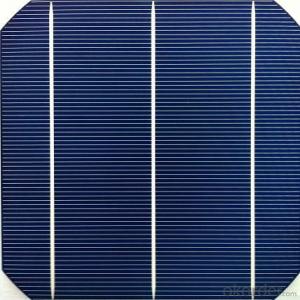Utj Solar Cells - Monocrystalline Silicon Solar Cells 125mm (16.50%-18.35%)
- Loading Port:
- Shanghai
- Payment Terms:
- TT OR LC
- Min Order Qty:
- 1000 watt
- Supply Capability:
- 100000000 watt/month
OKorder Service Pledge
OKorder Financial Service
You Might Also Like
Specification
1.Description of the Solar Cells
Monocrytalline Silicon Solar Cells 125mm (16.50%----18.35%)
We supply regular mono 125x125mm and poly 156x156mm solar cells.
Cells made in China mainland and Taiwan are both available.
Cell production capacity yearly reach 1GW.
Our cells pattern include continuous and uncontinuous busbar to meet different cells line.
2.Mechanical data and design of the Solar Cells
| Format | 125 mm × 125 mm ± 0.5 mm |
| Thickness- | 210 μm ± 40 μm |
| Front (-) | 1.6 mm bus bars (silver),blue anti-reflection coating (silicon nitride) |
| Back (+) | 2.5 mm wide soldering pads (silver) back surface field (aluminium) |
3. Temperature Coefficient of the Solar Cells
| Voc. Temp .coef.%/K | -0.35%/K |
| Isc . Temp .coef.%/K | +0.024%/K |
| Pm. Temp. coef.%/K | -0.47%/K |
4.Electrical Characteristic of the Solar Cells
Efficiency (%) | Pmpp (W) | Umpp (V) | Impp (A) | Uoc (V) | Isc (A) | FF (%) | ||
18.35 | 2.841 | 0.532 | 5.342 | 0.631 | 5.67 | 79.41% | ||
18.2 | 2.817 | 0.53 | 5.319 | 0.631 | 5.64 | 79.16% | ||
18.05 | 2.794 | 0.527 | 5.301 | 0.63 | 5.63 | 78.77% | ||
17.9 | 2.771 | 0.527 | 5.259 | 0.629 | 5.62 | 78.39% | ||
17.75 | 2.748 | 0.526 | 5.224 | 0.629 | 5.61 | 77.88% | ||
17.6 | 2.725 | 0.524 | 5.201 | 0.629 | 5.59 | 77.50% | ||
17.45 | 2.702 | 0.52 | 5.196 | 0.629 | 5.586 | 76.90% | ||
17.3 | 2.678 | 0.516 | 5.183 | 0.626 | 5.577 | 76.71% | ||
17.15 | 2.655 | 0.513 | 5.175 | 0.623 | 5.565 | 76.58% | ||
17 | 2.632 | 0.51 | 5.161 | 0.622 | 5.559 | 76.12% | ||
16.75 | 2.593 | 0.508 | 5.103 | 0.615 | 5.477 | 76.98% | ||
16.5 | 2.555 | 0.506 | 5.047 | 0.608 | 5.396 | 77.88% | ||
5.Intensity Dependence of the Solar Cells
Intensity [W/m2] | sc× [mA] | Voc× [mV] |
1000 | 1.00 | 1.000 |
900 | 0.90 | 0.989 |
500 | 0.50 | 0.963 |
300 | 0.30 | 0.939 |
200 | 0.20 | 0.920 |
6.IV Curve of the Solar Cells

7.Applications of the Solar Cells
electric power generation
8.IMages of the Solar Cells



FAQ
- Q: Can solar cells be used in water desalination?
- Yes, solar cells can be used in water desalination. Solar-powered desalination plants use solar energy to power the desalination process, usually through the use of photovoltaic (PV) panels. These panels convert sunlight into electricity, which can then be used to power the desalination process, such as reverse osmosis or distillation. This approach offers a sustainable and environmentally friendly solution to meet the increasing water demands in water-scarce regions.
- Q: What is the impact of extreme temperature fluctuations on solar cell efficiency?
- Extreme temperature fluctuations can have a significant negative impact on solar cell efficiency. High temperatures can cause the cells to overheat, leading to a decrease in their performance and efficiency. On the other hand, very low temperatures can also reduce their efficiency as the cells become less effective at converting sunlight into electricity. Therefore, it is crucial to consider temperature management in solar installations to optimize their efficiency and overall performance.
- Q: What is a monocrystalline Silicon Solar Cells?
- Monocrystalline Silicon Solar Cells consist of silicon in which the crystal lattice of the entire solid is continuous, unbroken to its edges, and free of any grain boundaries. Mono-Si can be prepared intrinsic, consisting only of exceedingly pure silicon, or doped, containing very small quantities of other elements added to change its semiconducting properties.
- Q: Can solar cells be used in theme parks or amusement parks?
- Yes, solar cells can definitely be used in theme parks or amusement parks. Solar cells can be installed on rooftops, parking lots, and other open spaces within these parks to generate clean and renewable energy. This energy can be utilized to power rides, lighting systems, water features, and other facilities within the park, reducing reliance on traditional power sources and lowering carbon emissions. Moreover, solar panels can also serve as educational tools, allowing park visitors to learn about renewable energy and sustainability.
- Q: Can solar cells be used in space satellites?
- Yes, solar cells can be used in space satellites. In fact, solar cells are the primary source of power for most satellites in space. They convert sunlight into electricity, providing a reliable and renewable source of energy for various satellite operations.
- Q: Can solar cells be used in shopping centers?
- Yes, solar cells can be used in shopping centers. They can be installed on the rooftops or in parking lots to generate clean and renewable energy to power the shopping center's operations. Solar cells provide cost savings on electricity bills and reduce carbon emissions, making them an environmentally friendly choice for shopping centers.
- Q: Can solar cells be used for off-grid applications?
- Yes, solar cells can be used for off-grid applications as they convert sunlight into electricity and can be utilized in remote areas or places lacking access to the traditional power grid. They provide a sustainable and reliable source of energy for powering various off-grid applications such as cabins, RVs, boats, and remote communication systems.
- Q: Can solar cells be used for powering data centers?
- Yes, solar cells can be used for powering data centers. Solar energy can be harnessed and converted into electricity through solar cells, which can then be used to power the energy-intensive operations of data centers. This renewable energy source can help reduce the environmental impact of data centers by decreasing their reliance on fossil fuels and mitigating carbon emissions. However, the feasibility of using solar cells for data centers depends on factors such as the availability of sunlight, the size of the data center, and the energy requirements of the facility.
- Q: Can solar cells be used for powering security systems?
- Yes, solar cells can be used for powering security systems. Solar cells convert sunlight into electricity, which can be used to power various devices including security systems. This renewable energy source is reliable, cost-effective, and environmentally friendly, making it a suitable option for powering security systems in remote locations or areas with limited access to electricity grids.
- Q: My solar cells are broken, can I just buy one and replace it?
- Trust me, you should hire a person who knows solar cells to help you.
Send your message to us
Utj Solar Cells - Monocrystalline Silicon Solar Cells 125mm (16.50%-18.35%)
- Loading Port:
- Shanghai
- Payment Terms:
- TT OR LC
- Min Order Qty:
- 1000 watt
- Supply Capability:
- 100000000 watt/month
OKorder Service Pledge
OKorder Financial Service
Similar products
Hot products
Hot Searches
Related keywords


































